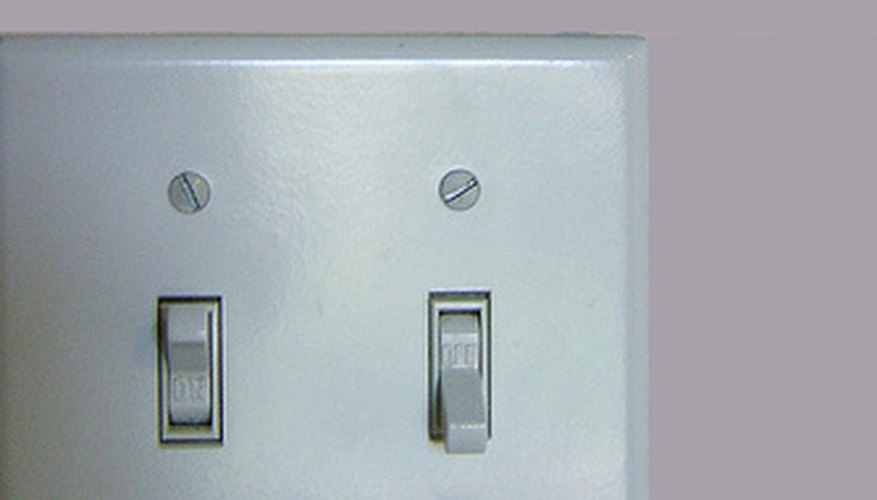Wiring two switches to control lights or receptacles on the same circuit is not much different than connecting two receptacles to provide a power outlet. Power is supplied to the switches through a hot wire.
It then travels through the switches to the light or receptacle and back to the circuit panel through the neutral wire. How you connect the wires makes all the difference -- doing it wrong can be anything from annoying to dangerous.
Turn off the power to the circuit at the circuit panel. Move the breaker switch from the on position to the off position.
Run cable from a power source such as a receptacle to the first switch, and from the first switch to the second switch. Also run sheathed cable from each switch to the light fixture. Strip six inches of sheathing from both ends of all the cables and push them into the boxes. Make sure at least one-fourth inch of cable sheathing is inside each box in addition to the six inches of cable that was stripped.
- Wiring two switches to control lights or receptacles on the same circuit is not much different than connecting two receptacles to provide a power outlet.
- Also run sheathed cable from each switch to the light fixture.
Connect the wires to the receptacle supplying the power to the switches. Strip three-fourths inch of insulation from both wires. Attach the bare ground wire to the green ground screw. Attach the white wire to the silver terminal and the black wire to the brass terminal.
Cut a six-inch piece of cable and pull the insulation off of it, leaving the white, black and bare wire. Strip one inch of insulation from one end of the black wire and three-fourths inch of insulation from the other end. Discard the white wire and save the black and bare wires.
- Connect the wires to the receptacle supplying the power to the switches.
- Cut a six-inch piece of cable and pull the insulation off of it, leaving the white, black and bare wire.
At the first switch, twist together all the bare ground wires from the cables and the six-inch piece and cap with a wire nut. Turn the end of the ground wire into a U shape and place it on the ground terminal. Tighten the screw snugly. Repeat this step at the second switch.
- At the first switch, twist together all the bare ground wires from the cables and the six-inch piece and cap with a wire nut.
Connect all three white wires together at the first switch. Twist the bare ends with the pliers and cap the connection with a wire nut. At the second switch, repeat this step with the two white wires.
Attach the incoming black wire from the receptacle to the outgoing black wire that runs to the second switch and to the six-inch piece of black wire. Twist the one-inch-long bare ends together and cap with a wire nut. Turn the short end of the black wire into a U shape with the pliers and attach it to the terminal on the switch. Tighten the terminal screw snugly. At the second switch, simply attach the incoming black wire from the first switch to a terminal on the switch.
- Attach the incoming black wire from the receptacle to the outgoing black wire that runs to the second switch and to the six-inch piece of black wire.
Attach the black wire that leads to the fixture at each switch, to the second terminal on the switch. Strip away three-fourths inch of insulation, bend it into a U shape and put it on the terminal, tightening the screw snugly.
Twist the ground wires together at the fixtures and cap the connections with wire nuts.
Connect the white wires and then the black wires. The fixture wires should already be stripped. Strip one inch of insulation from the white and black wires in the cable that leads back to the switch. Twist the white wires together, then the black wires. Cap the connections with wire nuts.
Fold the wires at each switch into the electrical box behind the switch. Attach the switch to the box with the supplied screws.
- Twist the ground wires together at the fixtures and cap the connections with wire nuts.
- Fold the wires at each switch into the electrical box behind the switch.
Cover the switches with wall plates. Most come with painted screws that match the wall plate.
Push and fold the wires at the fixture into the boxes and use care that no wires are pinched between the trim pieces and the electrical box. Add the screws or whatever means are supplied to attach the trim plate to the ceiling or wall.
TIP
If you're buying a wire stripper, get one that strips both sheathed cable and the wire inside the cable. These strippers work on both 14 AWG and 12 AWG wires. The order given for attaching wires is important. Always connect grounds first, neutrals second and hot (coloured) wires last. Ground wires are always bare or green. Neutral wires are white. All other colours are considered "hot" colours. Two wires attach to each switch. It won't matter which terminal you put those two wires on.
WARNING
This procedure is easy and safe enough for anyone to perform. However, if you are not comfortable working with electricity or remain unsure of how to proceed safely, stop and get help or hire a professional. Working on the wiring in your home exposes you to potentially dangerous and life-threatening electrical current. Always follow safety procedures, turn the power off and check to make sure it is off. Always check the circuit with a tester to make sure the power is off before beginning work. No-contact testers require that you only bring them close to a wire to detect current. Invest in a good no-contact tester.
